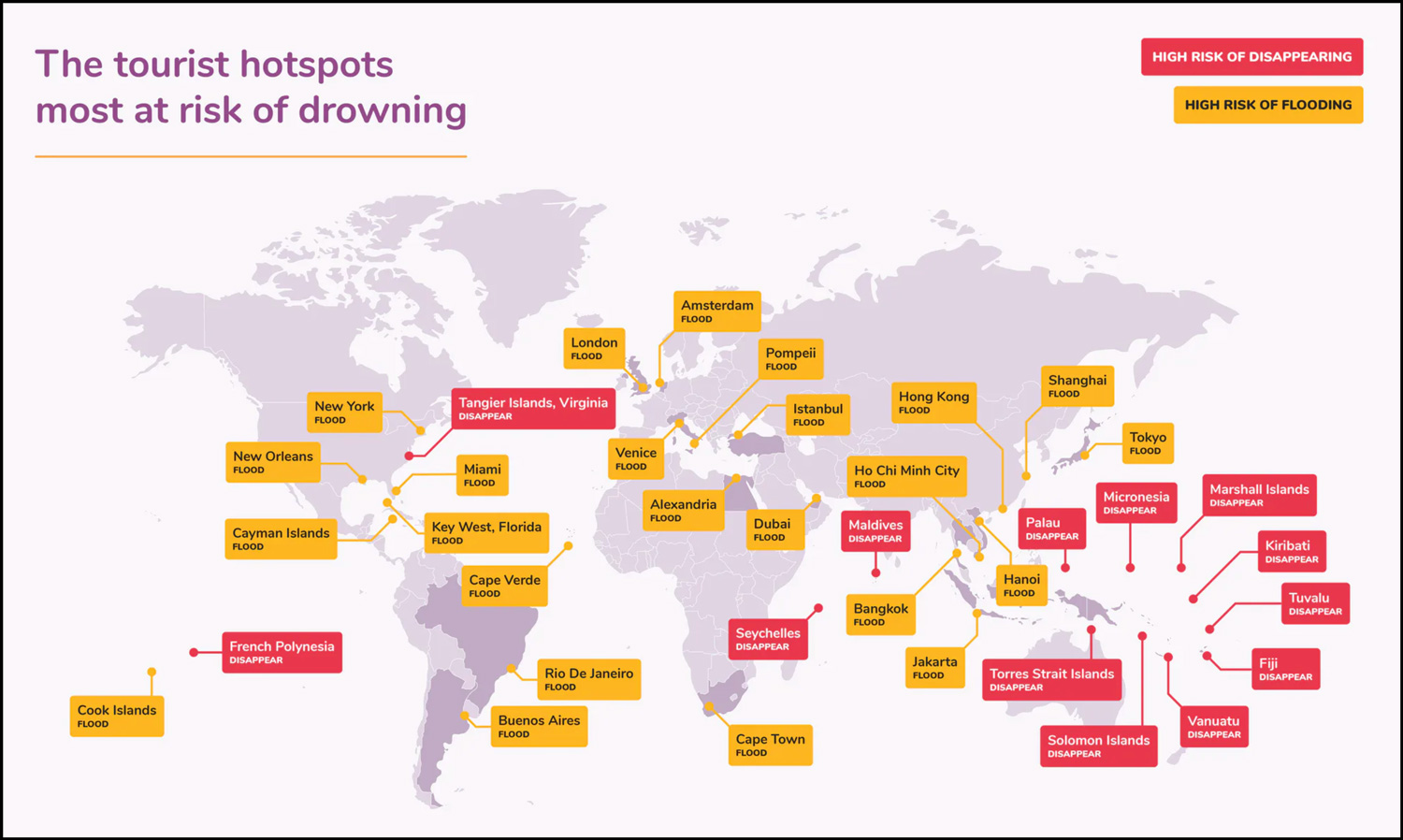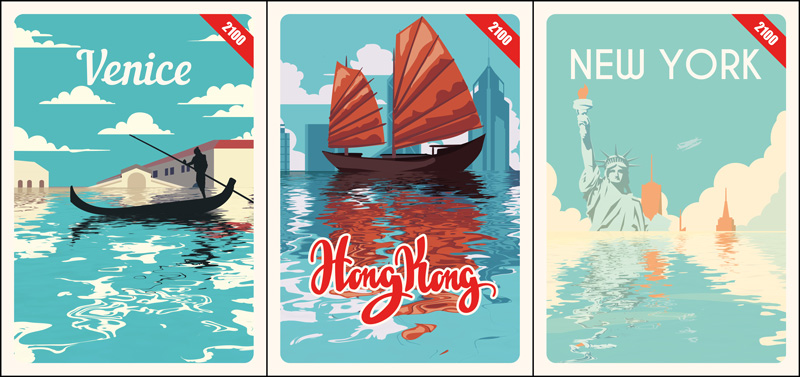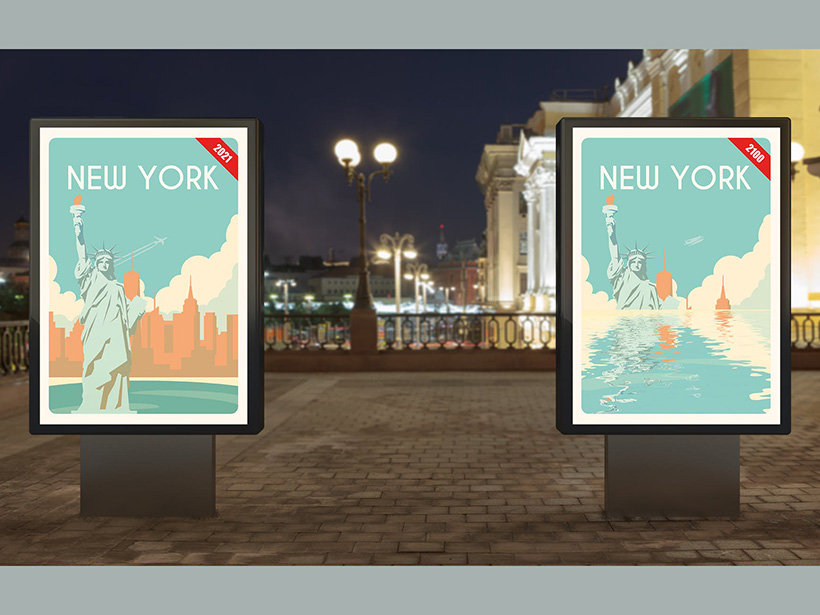
Climate change is causing ice caps to melt and sea levels to rise. And rising sea levels threaten to drown coastal tourist destinations.
To imagine this possible future—and spur action to combat it—the team at Money created tourist posters depicting iconic locales half submerged under rising sea levels: New York City, Venice, Hong Kong, and Maldives all waterlogged by 2100.

Maldives in particular “is at the frontline in the fight against climate change. We are one of the lowest lying countries in the world and are among the most vulnerable,” wrote Miuvaan Mohamed, director of communications at the Ministry of Foreign Affairs for the Republic of Maldives, in an email.
“It’s happening faster than scientists expected. And it’s happening sooner than scientists expected. And this, of course, influences our decision space,” said Zita Sebesvari, deputy director of the United Nations University for Environment and Human Security in Germany.
Sebesvari is a coauthor of the Special Report on the Ocean and Cryosphere in a Changing Climate, on which the new posters were based. The report was prepared by the Intergovernmental Panel on Climate Change to provide policymakers with a concise, usable synthesis of scientific knowledge for decisionmaking, Sebesvari said.
The report’s projections indicate that by 2100, sea levels could rise 0.43 meter if emissions fall in line with the goals set by the Paris Agreement—or almost double that at 0.84 meter if our emissions are slightly higher than they are now.
Our actions in reducing emissions today could drastically alter the course of sea level rise by the end of the century, Sebesvari said, but will not prevent it. By 2050, the oceans will likely still rise 0.24 meter even if we meet the lower-emissions targets, compared to 0.32 meter in the higher-emissions scenario.
And these estimates of sea level rise may still be low—past projections have undershot how quickly the sea actually rises, Sebesvari said. “In the past, science, unfortunately, always had to correct projections upwards, not downwards.”
It is important to note that there are regional differences in sea level rise, whereas the recent projections indicate the average sea level rise across the globe, Sebesvari said. “So talking about just mean sea level rise is underestimating the risk and potential impact.”
Tourism at Risk
The new poster series highlights tourist destinations and culture centers that are at high risk and whose culture and history are not replaceable.

Venice, for example, is sinking. In October 2020, the Italian city of canals raised its newly built sea walls to hold back high tides from flooding its streets and piazzas. But by 2100, the City of Water is projected to face waters a meter higher than they are today.
Higher sea levels will also mean amplified extreme weather events like typhoons and storm surges around coastal cities like Hong Kong and New York. China has invested in artificial islands and seawalls to protect Hong Kong, and public and private interests have supported the creation of a New York Harbor Storm Surge Barrier. This project would include a series of floodgates across Lower New York Bay from New Jersey to New York, as well as additional barriers in the East River.
In an effort to mitigate (not prevent) the effects of sea level rise, hotels along the Mexican coast are insuring the coral reefs that protect the coastline from storm surges.
To protect against extreme events, “the question is how much money and how much land it costs to build those protection systems even higher,” Sebesvari said. “So it’s really a matter of cost-benefit in terms of what can be paid to protect what.”
“An Existential Threat”

Expensive protections like sea walls might not be available in places like the world’s low-lying islands. More than three quarters of the tropical islands of Maldives, for instance, are projected to be underwater by 2100, and much of the local population will need to be relocated.
“Sea-level rise, unpredictable weather and other environmental phenomena caused by human activity are soon going to leave us homeless,” Mohamed wrote. “It is an existential threat.”
“Our lived reality, our nation’s entire life is dependent on the elements of nature. Our economy is strongly reliant on tourism and fisheries sectors, which is intertwined with the environment,” he added.
In 2004, the Indian Ocean tsunami flooded more than half of Male, the Maldivian capital, in hours, damaging key infrastructure and services.”Complete island communities were displaced and had to be relocated,” Mohamed wrote. “Not only this but tourist resort islands, which contribute a major percentage of [Maldives’s] income, were destroyed, leaving our economy very fragile. This is our everyday reality.”
“We really need to cut emissions because sea level rise otherwise becomes unmanageable.”
Sebesvari urged travelers and industry leaders to preserve both tourist destinations and other at-risk coastal areas. “We really need to cut emissions because sea level rise otherwise becomes unmanageable,” she said.
Maldives is currently working toward net zero emission by 2030 by increasing the use of renewable energy while simultaneously refurbishing its architectural framework to increase resilience to sea level rise, Mohamed wrote.
“In order to deal with the issue of sea-level rise, I believe it is important to formulate future plans that focus on resilience and sustainability,” he added. “In fact, if we want desirable outcomes, we need to adopt a hybrid plan that has attributes of both adaptation and mitigation.”
—Richard J. Sima (@richardsima), Science Writer
This story is a part of Covering Climate Now’s week of coverage focused on “Living Through the Climate Emergency.” Covering Climate Now is a global journalism collaboration committed to strengthening coverage of the climate story.
Citation:
Sima, R. J. (2021), Rising sea levels bring a tidal change to tourism, Eos, 102, https://doi.org/10.1029/2021EO157200. Published on 22 April 2021.
Text © 2021. The authors. CC BY-NC-ND 3.0
Except where otherwise noted, images are subject to copyright. Any reuse without express permission from the copyright owner is prohibited.

